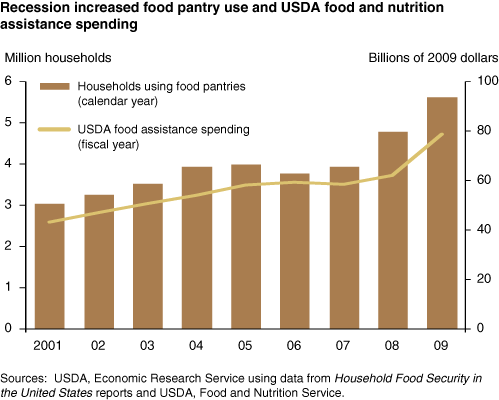More Americans Relied on Food Assistance During Recession
- by Margaret Andrews
- 12/1/2010
During the recent recession, many U.S. households suffered job losses, declining incomes, home foreclosures, and diminished net worth. Food security—consistent, dependable access to enough food for active, healthy living—is vulnerable to these financial challenges.
In 2009, 14.7 percent of U.S. households (17.4 million) were food insecure, meaning that at some time during the year, they had difficulty providing enough food for all members due to insufficient resources. The percentage was essentially unchanged from 2008 (14.6 percent), remaining at the highest level observed since food security surveys were initiated in 1995.
More households have sought additional resources from public and private sources. Since 2001, the number of households that reported obtaining emergency food from a food pantry over the previous 12 months rose. The largest increase occurred between 2007 and 2009, when households using food pantries rose by 44 percent from 3.9 to 5.6 million households.
Over the same period, food pantry use by married-couple families rose 66 percent; multiple-adult households without children, 57 percent; and households located in the Midwest, 65 percent. The number of food pantry users grew at about the same rate in metro and nonmetro areas in 2007-09. In 2009, however, food pantry use in suburban areas topped that in principal cities for the first time since 2001.
Households also accessed additional assistance through USDA’s 15 food and nutrition assistance programs. Government spending, in inflation-adjusted dollars, for these programs increased 27 percent in 2009 due to a significant hike in Supplemental Nutrition Assistance Program (SNAP) benefits enacted as part of the 2009 stimulus package and record growth in the SNAP caseload. In fiscal year (FY) 2009, 15.2 million households participated in SNAP in an average month—up from 12.7 million in FY 2008.
ERS monitors the extent and severity of food insecurity in U.S. households annually through the Food Security Supplement to the nationally representative Current Population Survey. The supplement collects information from some 46,000 households on conditions and behaviors that are indicative of food insecurity. Data on household food expenditures and use of Government and private food and nutrition assistance also are collected.
This article is drawn from:
- Food Security in the U.S.. (n.d.). U.S. Department of Agriculture, Economic Research Service.
- Nord, M., Coleman-Jensen, A., Andrews, M. & Carlson, S. (2010). Household Food Security in the United States, 2009. U.S. Department of Agriculture, Economic Research Service. ERR-108.


